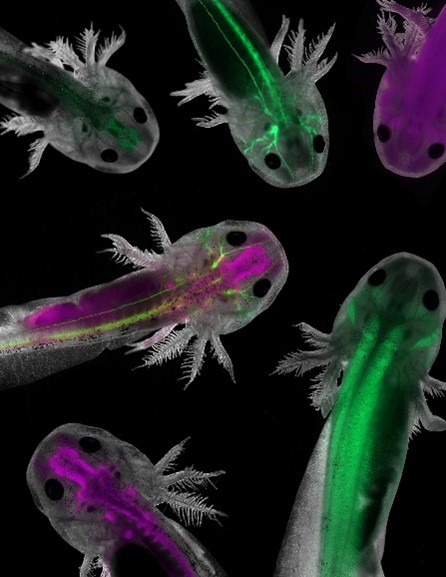
You may wonder how scientists study something as tiny as DNA. Over the past decades, researchers have developed a wide range of tools and techniques to help them unlock the secrets of human genomes and those of other organisms. Two key examples are DNA sequencing and gene editing.
DNA Sequencing
DNA sequencing, sometimes called gene or genome sequencing, enables researchers to “read” the order of the bases in a segment of DNA, which contains the information a cell needs to make important molecules like proteins, the functional building blocks of the cell. There are several methods for sequencing, but they all require many copies of the same DNA segment to get accurate results. Fortunately, scientists have developed a technique called polymerase chain reaction, often referred to as PCR, that can quickly and inexpensively create a large number of copies of a DNA segment.
Researchers use DNA sequencing to learn about the structure of genes and their connections to traits in humans and other organisms. They can also study the evolutionary relationships between species by sequencing their DNA and comparing the results. They’ve used this technique to make discoveries, such as turtles being more closely related to birds than to lizards and snakes.
Clinicians can use DNA sequencing to determine if a person has a version of a gene that causes or puts them at risk for disease. For example, many people are tested for variants of the BRCA1 and BRCA2 genes that increase the risk of breast cancer. DNA sequencing can also show if someone has a version of a gene that might make them respond differently to certain medicines. For example, there are versions of the CYP2C19 gene that affect the dose of the blood thinner clopidogrel that will be effective for a person.
The Human Genome Project, a large international collaboration that included the newly created National Institutes of Health’s National Human Genome Research Institute, produced the first sequence of the human genome. The project ran from 1990 to 2003, when researchers produced a sequence that accounted for 92 percent of the genome, which is as close to complete as technology allowed at the time. In 2022, researchers announced that they had filled in the gaps in the original human genome sequence to create the first complete sequence.
Gene Editing
Gene editing is a method researchers developed to cut and paste specific sequences of DNA in living cells. This process can improve our understanding of gene function, and researchers are also developing ways to use it to treat genetic or acquired diseases.

The gene-editing method used most often today is called CRISPR, and scientists discovered it through research on how bacteria defend themselves against viruses. CRISPR works by cutting a DNA sequence at a specific genetic location and deleting or inserting DNA sequences, which can change a single base pair of DNA, large pieces of chromosomes, or the regulation of gene expression levels. Researchers use CRISPR in a wide variety of ways, including inactivating a gene to learn about its function and incorporating disease-causing DNA segments into cells, which they can then use to test potential treatments.
In 2020, Emmanuelle Charpentier, Ph.D., and NIGMS grantee Jennifer Doudna, Ph.D., won the Nobel Prize in chemistry for developing CRISPR as a genome-editing method.
Research Organisms
Scientists study not only human DNA but also that of many other creatures, sometimes called research organisms. Because all living things evolved from a common ancestor, they share many of the same genes, and the molecules made from those genes function in similar ways. Scientists can study shared DNA in research organisms to improve our understanding of how human genes, including those associated with disease, function and are controlled.

Research organisms can be especially helpful in investigating the causes of diseases and potential treatments. The natural course of a disease in humans can take dozens of years, but a research organism can quickly develop a version of a disease and indicate if a potential treatment could be safe and effective. This helps scientists advance their research in much less time.
Scientists also study the genes of research organisms for the ways they differ from humans. For example, researchers are studying axolotl genomes to learn how they can regrow body parts that humans can’t. Ultimately, this could enable the development of therapies to improve human wound healing or even regeneration.
In addition, researchers study the genes of beneficial and disease-causing bacteria, viruses, and fungi. This work can help them understand the human microbiome’s role in health and how to possibly prevent or treat infections from harmful bacteria.
Scientists have learned a great deal about the human genome and its effects on health, but there are still many more questions to investigate through genetics tools and research organisms.

Find the teaching activity that corresponds with this post in our Educator’s Corner.






